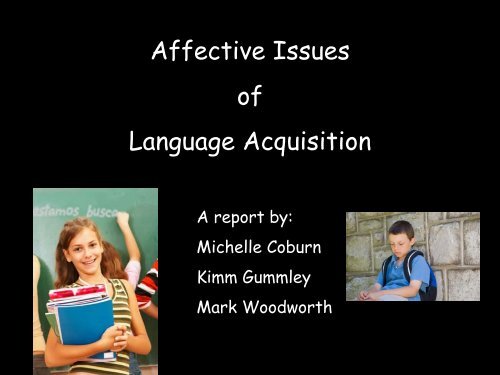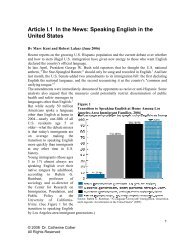Affective Issues of Language Acquisition
Affective Issues of Language Acquisition
Affective Issues of Language Acquisition
Create successful ePaper yourself
Turn your PDF publications into a flip-book with our unique Google optimized e-Paper software.
Feelings and Emotions
The <strong>Affective</strong> Domain
<strong>Affective</strong> Filter Hypothesis<strong>Affective</strong> variables that relate to success insecond language acquisition are:• Motivation• Self-Confidence• Anxiety(Krashen, 1981)
How high is your filter?High filterLow filter
Implications for the classroom• seek to provide input that is comprehensiblei +1 (input just above the learner’s current level)• and create a low anxiety learning environment
Krashner’s <strong>Affective</strong> Filter TheoryInputFilter<strong>Language</strong><strong>Acquisition</strong>DeviceAcquiredCompetenceL.A.D.
Strategies for Teachers and FamiliesParent WorkshopsTeacher/Staff TrainingCooperative StrategiesCultural AwarenessClear ExpectationsCommunity EventsIDifferentiating InstructionInteractive Strategies
Parent Workshops
Strategies for Students and Families1. Emotional Coping Strategies2. Self-Awareness3. Goal-setting4. Fostering Home-School Partnership
Home-School activitiesBuilding family literacy
Cooperative and Interactive StrategiesMaximize <strong>Language</strong> <strong>Acquisition</strong>Maximize Social Development<strong>Language</strong> Functions and Social Skills
Effective Culturally Diverse ClassroomA self-awareness <strong>of</strong> attitude on multiculturalism and strengths andweaknesses in working with people from different cultural backgrounds.An ability to think critically, analytically, and creativelyAn ability to challenge and stimulate students to learn to apply criticalthinking skills.A sensitivity to and appreciation <strong>of</strong> individual differences.A positive attitudeA willingness to integrate a multicultural perspective in the classroom andcurriculum.A willingness to build and strengthen curriculum bridges among home, school,and community.
Cultural Awareness Activities
QuickTime and aTIFF (Uncompressed) decompressorare needed to see this picture.
BibliograhyCollier, C. (2008). Handbook for second language acquisition.Ferndale, WA: Crosscultural Developmental Educational Services.Escort, (2001). The help! Kit. A resource guide for secondaryteachers <strong>of</strong> migrant english language learners. Oneonta, NY:Escort.Krashen, S. (1981) Second language acquisition and secondlanguage learning. Oxford: Pergamon Press.Krashen, S. (1982). Principles and practices in second languageacquisition. New York: Pergamon Press Inc.Krathwohl, D. R., Bloom, B. S., & Masia, B. B. (1973). Taxonomy <strong>of</strong>Educational Objectives, the Classification <strong>of</strong> Educational Goals.Handbook II: <strong>Affective</strong> Domain. New York: David McKay Co., Inc.Seels and Glasgow (1990). Exercises in instructional design.Columbus OH: Merrill Publishing Company.
Bibliograhy cont.Winner, M. G., (2007). Worksheets! For teaching social thinkingand related skills. San Jose, CA: Think Social Publishing, Inc.(Online Magazine) On the cutting edge: pr<strong>of</strong>essional developmentfor geoscience(Title <strong>of</strong> Edition) Student motivations andattitudes: The role <strong>of</strong> the affective domain in geoscience learning.(Article Title) The affective domain in teachinghttp://serc.carleton.edu/NAGTWorkshops/affective/index.htmlJune 24, 2009(Parent Guide) Life SuccessWWW.ldsuccess.org/parent_guide/what_are/emotional.html) 2003

















